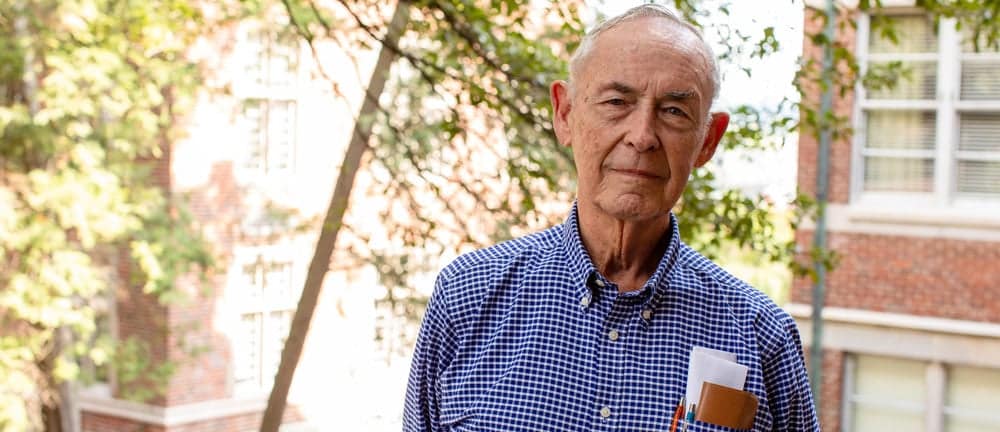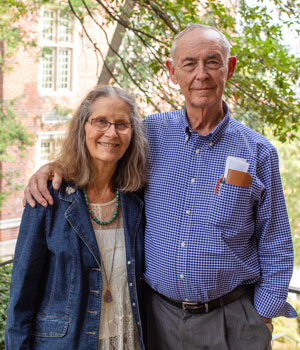
Bob Luther (’63) bought a wrecked Cessna 210 in 1969 and rebuilt it.
“I’ve flown it ever since, and I like it, so I’m not about to part with it,” Luther said.
Recently, however, another airplane caught his attention. It was a 1947 fabric Stinson parked in a barn near Portland, Oregon. Luther bought it, rebuilt it as a show plane, and added it to his hangar.
“I’ve flown it ever since, and I like it, so I’m not about to part with it,” Luther said.
Recently, however, another airplane caught his attention. It was a 1947 fabric Stinson parked in a barn near Portland, Oregon. Luther bought it, rebuilt it as a show plane, and added it to his hangar.
“It’s been interesting correcting all of the things it needed to fly straight and level as well as getting all of the instruments working,” Luther said. “It’s ready now, though, and I’ve made two flights in it. I’m looking forward to the third.”
Susan Luther, a poet, is supportive of her husband’s hobby.
“I think it’s wonderful,” she said. “It’s his passion, and I wouldn’t have him do anything else because you need to follow your passion if at all possible. I knew when I married him that aviation was important to him, and therefore it’s important to me.”
Susan Luther, a poet, is supportive of her husband’s hobby.
“I think it’s wonderful,” she said. “It’s his passion, and I wouldn’t have him do anything else because you need to follow your passion if at all possible. I knew when I married him that aviation was important to him, and therefore it’s important to me.”

Aviation isn’t only Luther’s hobby, it has been the cornerstone of his career in engineering, management, and entrepreneurship. As founder and executive vice president of Paragon Systems Inc., Luther spent 18 years working on contracts for NASA, the Department of Defense, and other government entities.
Prior to founding Paragon, he worked for several aerospace corporations and notably developed systems for the Hubble Space Telescope, the Rocketdyne F-1 engine, and the Saturn I, Saturn IB, and Saturn V rockets as well as numerous satellites.
Given his accomplishments, it stands to reason that the task of making personal airplanes flightworthy again would be relaxing for Luther. In both his professional and personal endeavors, he uses skills learned from his time in the Tickle College of Engineering.
During the 60s, Luther paid his way through UT by working from 6 p.m. to 2 a.m. every day as a printer for the Knoxville News Sentinel. He grew up with the printing trade as the family’s business and worked for 43 newspapers and 14 printing plants before switching to engineering. He briefly owned a weekly newspaper after his time in the US Navy working on repairing fighter aircraft like the Grumman F8 Bearcat. To this day he maintains two vintage printing presses and a 1937 Model 8 Linotype in his airplane hangar, which doubles as an office. His oldest press is a 1905 Chandler & Price hand fed printing press.
During his time at UT, Luther once butted heads with the dean of engineering, who didn’t believe working a full-time night shift and carrying a full course load could be possible. “I was just determined to get through electrical engineering, though,” Luther said. “When the dean called me into his office, he said, ‘You’re crazy.’ But I told him, ‘Sir, that’s the only way I have to get through college.’”
Luther did have a monthly GI bill income of $139 because during the Korean War he ran aircraft electronics maintenance shifts for a fighter squadron of F-8 Bearcats and F-6 Hellcats in Kingsville, Texas. However, that support alone was not enough.
“You couldn’t live on $139 a month and buy books and all that,” Luther said. “I had to work and, of course, had the master journeyman’s card in the typographical union and so was making pretty good money. The dean didn’t like it, but I didn’t see him anymore until he handed me a diploma at graduation.”
With his diploma, Luther built a formidable career that spanned decades. Currently, he is the president of Hazel Green Airport in Alabama and the author of several books, including Skybolt, Tramp Printer, and Corporate Space.
Prior to founding Paragon, he worked for several aerospace corporations and notably developed systems for the Hubble Space Telescope, the Rocketdyne F-1 engine, and the Saturn I, Saturn IB, and Saturn V rockets as well as numerous satellites.
Given his accomplishments, it stands to reason that the task of making personal airplanes flightworthy again would be relaxing for Luther. In both his professional and personal endeavors, he uses skills learned from his time in the Tickle College of Engineering.
During the 60s, Luther paid his way through UT by working from 6 p.m. to 2 a.m. every day as a printer for the Knoxville News Sentinel. He grew up with the printing trade as the family’s business and worked for 43 newspapers and 14 printing plants before switching to engineering. He briefly owned a weekly newspaper after his time in the US Navy working on repairing fighter aircraft like the Grumman F8 Bearcat. To this day he maintains two vintage printing presses and a 1937 Model 8 Linotype in his airplane hangar, which doubles as an office. His oldest press is a 1905 Chandler & Price hand fed printing press.
During his time at UT, Luther once butted heads with the dean of engineering, who didn’t believe working a full-time night shift and carrying a full course load could be possible. “I was just determined to get through electrical engineering, though,” Luther said. “When the dean called me into his office, he said, ‘You’re crazy.’ But I told him, ‘Sir, that’s the only way I have to get through college.’”
Luther did have a monthly GI bill income of $139 because during the Korean War he ran aircraft electronics maintenance shifts for a fighter squadron of F-8 Bearcats and F-6 Hellcats in Kingsville, Texas. However, that support alone was not enough.
“You couldn’t live on $139 a month and buy books and all that,” Luther said. “I had to work and, of course, had the master journeyman’s card in the typographical union and so was making pretty good money. The dean didn’t like it, but I didn’t see him anymore until he handed me a diploma at graduation.”
With his diploma, Luther built a formidable career that spanned decades. Currently, he is the president of Hazel Green Airport in Alabama and the author of several books, including Skybolt, Tramp Printer, and Corporate Space.